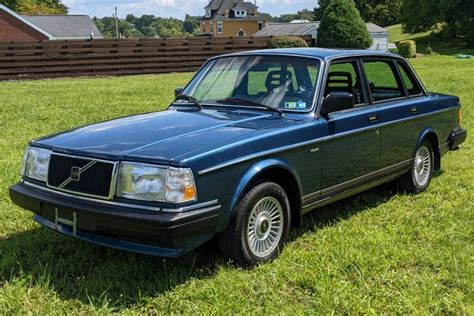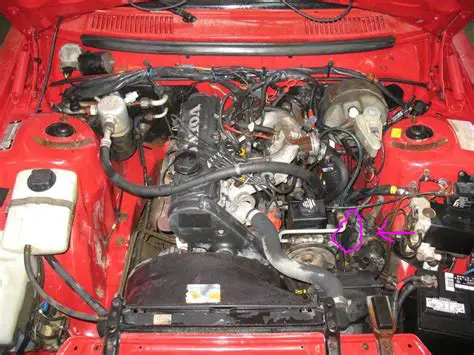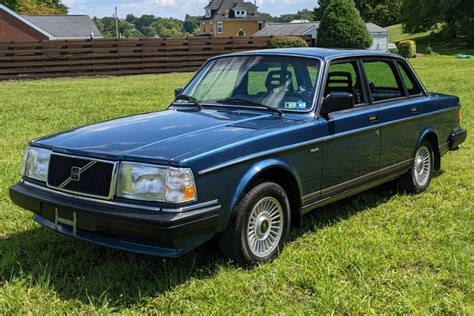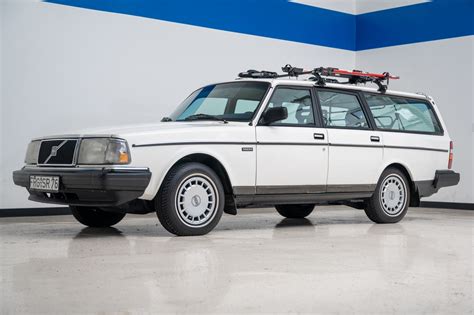1988 Volvo 240 problems

The Volvo 200 Series (or 240 and 260 Series) is a range of mid-size cars produced by Swedish company Volvo Cars from 1974 until 1993, with more than 2.8 million total units sold worldwide. Like the Volvo 140 Series (1966 to 1974), from which it was developed, it was designed by Jan Wilsgaard.
The series overlapped production of the Volvo 700 Series (1982 to 1992). As the 240 Series remained popular, only the 260 Series was displaced by the 700 Series, which Volvo marketed alongside the 240 for another decade. The 700 was replaced by the 900 Series in 1992, a year before the 240 was discontinued. Production of the 240 ended on 14 May 1993, after nearly 20 years, with the basic platform and architecture lasting 27 years, if the production run of the original 140 Series is aggregated.
History
The Volvo 240 and 260 series were introduced in the autumn of 1974, and was initially available as six variations of the 240 Series (242L, 242DL, 244DL, 244GL, 245L and 245DL) and two variations of the 260 Series (264DL and 264GL). The 240 Series was available as a sedan (with two or four doors) or a station wagon, however, the 260 Series was available as a coupé (262C Bertone), two-door sedan, four-door sedan, or station wagon. The 200 looked much like the earlier 140 and 164, they shared the same basic body shell and were largely identical from the cowl rearward. However, the 200 incorporated many of the features and design elements tried in the Volvo VESC ESV in 1972, which was a prototype experiment in car safety. The overall safety of the driver and passengers in the event of a crash was greatly improved with very large front and rear end crumple zones. Another main change was the new engines offered, which were of an overhead cam design based on the earlier B20. The 260 series also received a V6 engine in lieu of the 164's inline-six.
The 200 Series had MacPherson strut-type front suspension, which increased room around the engine bay, while the rear suspension was a modified version of that fitted to the 140 Series. The steering was greatly improved with the introduction of rack-and-pinion steering, with power steering fitted as standard to the 244GL, 264DL and 264GL, and there were some modifications made to the braking system (in particular the master cylinder).
The front end of the car was also completely restyled with a "shovel nose" which closely resembled that of the VESC prototype vehicle – that being the most obvious change which made the 200 Series distinguishable from the earlier 140 and 160 Series. Other than all the changes mentioned above, the 200 Series was almost identical to the 140 and 160 Series from the bulkhead to the very rear end. In 1978, a facelift meant a redesigned rear end for sedans, with wraparound taillights and a trunk opening with a lower lip. The dashboard was derived from the safety fascia introduced for the 1973 model year 100 Series - the main change for the 200 Series was the adoption of slatted "egg crate" style air vents in place of the eyeball style vents used in the 140/160 and the square clock. All models were available with a choice of four-speed manual or a three-speed automatic transmission. Overdrive was also optional on the manual 244GL, while a five-speed manual gearbox was optional on the 264GL and 265GL.
In the autumn of 1975 (for the 1976 model year in America), the 265 DL estate became available alongside the existing range, and this was the first production Volvo estate to be powered by a six-cylinder engine. The choice of gearboxes was also improved, with overdrive now available as an option in all manual models except the base-model 242L and 245L. As before, a three-speed automatic was optional in every model. The B21A engine gained three horsepower; a new steering wheel and gearknob were also introduced.
At the 1976 Paris Motor Show Bertone first showed the stretched 264 TE, a seven-seat limousine on a 3,430 mm (135.0 in) wheelbase, although it had entered production earlier. The raw bodies were sent from Sweden to Grugliasco for lengthening, reinforcing, and finishing. Carl XVI Gustav of Sweden used one, as did much of East Germany's political leadership.
For 1977 the B19A engine with 90 PS (66 kW) replaced the B20A in most markets, although the old pushrod type soldiered on for another two years in some places. This is also the year that the sportier 242 GT arrived.
In 1978 the grille was altered, now with a chrome surround. Rear view mirrors were now black, while the front seats were changed as were the emblems, while interval wipers were introduced. 1978 models were also the first 240s to receive a new paint formula, to help solve the severe rust problems in previous model years.
The 1979 model year brought a full facelift front and rear, the most obvious change being the adoption of flush fitting square headlamps on the DL or rectangular headlamps on the GL, GLE in place of the recessed circular units. The sedans received new wraparound rear lamp clusters and a restyled leading edge to the trunk lid, while the rear of the wagons remained unchanged. The GLE was added while the L was cancelled, and the six-cylinder diesel arrived late in the year. For 1980, the sporty GLT arrived, replacing the GT. For 1981 there was yet another new grille, while the station wagons received new, wraparound taillights. The B21A gained some four horsepower, now 106 PS (78 kW), while the carburetted B23A with 112 PS (82 kW) was introduced in some markets. The Turbo arrived, while six-cylinder models now had a more powerful 2.8-liter engine. 1981 also saw the dashboard altered significantly, which a much larger binnacle in order to bring the radio and clock within the driver's line of sight. The instrument pod itself, which had been unaltered since the 1973 model year 100 Series, was also redesigned.
Incremental improvements were made almost every year of the production run. One of the major improvements was the introduction of the oxygen sensor in North America in late 1976 (1977 models), which Volvo called Lambda Sond and developed in conjunction with Bosch. It added a feedback loop to the Jetronic fuel injection system already in use, which allowed fine-tuning of the air and fuel mixture and therefore produced superior emissions, drivability and fuel economy.
For the 1983 model year, Volvo dropped the DL and GLE labels, selling the cars simply as 240s. In the domestic Swedish market, the 240 could be had with a 2.1 or 2.3-liter engine (more options were available in export), but the bigger engine always came coupled with a five-speed transmission and tinted windows. The 1983s also received wider side trim and all models had the larger taillights introduced on the previous year's GLT model. A B23E-engined GLE variant was also added (not available with two doors). Buyers protested against the lack of grades and they returned for 1984. A new manual gearbox also arrived for 1984, while a four-speed automatic option was available in the GL. The GLT and Turbo versions received a taller grille.
While Volvo had been planning to discontinue the 200-series since the early 1980s, the design kept selling well and Volvo provided steady updates. In late 1991, for the 1992 model year, it received 160 detail improvements including changes to the heater controls, heated rear view mirrors, and revised front seats. For the final, 1993 model year, air conditioning units were upgraded to use R-134a rather than the ozone-depleting R-12 (Freon).
About one-third of all 240s sold were station wagons, which featured very large cargo space of 41 cubic feet (1.2 m3). They could be outfitted with a rear-facing foldable jumpseat in the passenger area, making the wagon a seven-passenger vehicle. The jumpseat came with three-point seat belts, and wagons were designed to have a reinforced floor section, protecting the occupants of the jumpseat in the event of a rear-end collision.
A 1993 Volvo 240DL was driven by IKEA founder Ingvar Kamprad, who stopped driving it when he was told the car was too dangerous due to outdated safety design two decades later.
The last 200 produced was a blue station wagon built to the Italian specification and named the "Polar Italia", currently displayed at the Volvo World Museum. It was manufactured the 14th May 1993.

Social links
Common 1988 Volvo 240 problems
The Volvo 240, produced between 1975 and 1993, is a popular car among Volvo enthusiasts due to its robust design and longevity. However, as with any vehicle, it has its share of common problems. Here are some of the most frequently reported issues with the Volvo 240, based on complaints from owners:
- Overdrive Inoperative or Upshift Arrow On All the Time: This issue is common in the 1975-1988 240 models, and it is often caused by a problem with the overdrive relay, wiring, switch, or solenoid. The most common problem is the disconnection of the OD button wires from the switch due to the shift knob accidentally being pulled off. The wires below the shifter can also fail from being flexed back and forth thousands of times. The switch in the gear shift knob can go bad, and the wiring where it connects to the solenoid on the driver side of the transmission can also have issues. The solenoid and the overdrive itself can also fail due to the loss of hydraulic pressure as they age.
- Fuel Injection Relay Failure: This issue affects the 1978-1985 240 models and is caused by the failure of the main fuel pump relay due to overheating of the main 12V power connection. This failure is often caused by a failed pre pump in the gas tank, which overworks the main fuel pump and causes it to draw excessive amperage. Symptoms of a faulty pre pump include poor idle quality, hesitation when accelerating, reduced fuel economy, loud humming noises emanating from the main pump, and accelerated wear of the main pump.
- Corrosion of the Fuse Box: The main fuse box located in the driver side kick panel of the Volvo 240 is susceptible to corrosion from water that can enter the interior and drip directly onto the fuses. The small contact area of the European ceramic style fuses also leads to corrosion due to electrolosis. Prevent numerous problems associated with the fuse box by pulling all fuses and cleaning them annually.
- Worn Air Intake Hose and Air Box Thermostats: Volvo 240 models with Bosch LH electronic fuel injection have a large plastic accordion style intake hose that connects the air mass meter to the intake manifold. Over time, a hole can wear through where it touches the inner fender, allowing unfiltered and unmetered air to enter the engine. This can cause erratic behavior and reduced performance. The air box thermostat, which routes hot air from the exhaust manifold to aid in cold start performance, can also fail, causing super heated air to be drawn into the engine and reducing performance.
- Engine Coolant Leaking into the Passenger Compartment: This issue is often caused by a leaking heater valve but can sometimes be due to a leaking heater core. It can result in engine coolant leaking into the passenger compartment and causing problems with the car's heating and cooling system.
- Worn Seats: The seats in the Volvo 240 are very comfortable when they are in good condition, but the lumbar support system commonly fails between 50-100,000 miles. The bottom seat cushion support grid is also a weak spot, causing drivers to struggle when trying to see over the steering wheel when it fails. This part was discontinued by Volvo a few years ago and has been replaced with an improved version.
- Watertight Fuse Holder: For owners of 1982-89 non-turbo Volvo 240 series, Volvos with LH fuel injection, a watertight fuse holder is recommended to prevent water from entering the fuse box and causing corrosion.
- Idling Problems: When a car has been standing for a long time, there are many parts that can deteriorate or stop working due to lack of use. Idling problems can be caused by a variety of issues, including a dirty throttle valve housing, a malfunctioning idle air regulation valve, and issues with the fuel pressure, fuel injectors, coolant temperature sensor, air mass meter, and air induction system.

Are old Volvo 240s reliable?
8 Robust And Ultra-Reliable
Being the first manufacturer to fit 999,999 mph odometers to its cars, Volvo was underlining its vehicle's potential for longevity, and thanks to many galvanized parts, excellent build quality, and almost bomb-proof mechanicals, the 240 continues to spin those digits.
How long will a Volvo 240 last?
I have several 240 customers with well over 300k miles and they still run like a brand new car. Most of their interiors have seen better days, as dash and console cracks, door panels coming apart etc are common fair. The drive train however, if taken care of even a little bit it will last a long, long time.
Does the Volvo 240 handle well?
A Volvo 240 is unlike any other car. There is no limit to the number of miles you can put on one of these IF you take care it. They are not particularly fast but with a few minor modifications can be made to handle suprisingly well.
Are Volvo 240 rare?
Globally, the Volvo 240 is far from a rare vehicle. There were over 2.8 million models built using the 240 designation over its entire run, with a further 177,000 nearly-identical 260s produced during the same period.
Are old Volvo 240s reliable?
8 Robust And Ultra-Reliable
Being the first manufacturer to fit 999,999 mph odometers to its cars, Volvo was underlining its vehicle's potential for longevity, and thanks to many galvanized parts, excellent build quality, and almost bomb-proof mechanicals, the 240 continues to spin those digits.
Is the 1988 Volvo 240 RWD?
1988 Volvo 240 GL 2.3L Sedan RWD.
Is the Volvo 240 a safe car?
More than anything else, it was the car's crash safety properties combined with the fine driving characteristics which attracted attention when the car appeared on the market the world over. for Highway Safety, IIHS, cited the Volvo 240 Estate as the safest car on the American market.
How long did the Volvo 240 last?
20 years
On 5th May 1993, after nearly 20 years of huge success and 2,862,573 cars produced (of which 177,402 were 260s), the 240 took its final bow.
1988 Volvo 240 car problems categorized by type of issue
After analyzing all complaints sent to the NHTSA and researching popular Volvo 240 problems, we found that the most common problems with these 2023 model year vehicles are:
- Tires problems
- Engine and engine cooling problems
- Vehicle speed control problems
- Seat belts problems
- Unknown or other problems
The graph below shows statistics for all 1988 Volvo 240 vehicle components and the number of complaints received.
1988 Volvo 240 complaints
The NHTSA has received 14 complaints about various vehicle components related to the 1988 Volvo 240.
SEAT BELTS PROBLEM
- Date Of Incident: 1992-04-07
- Number Of Injuries: 1
- Crash: 1
- Components: SEAT BELTS
- Summary: I WAS DRIVING TO WORK AND IT WAS DARK AND FOGGY. I WAS GOING SLOWLY AROUND A CURVE, AT THE SPEED LIMIT ABOUT 20MPH, AND A TEENAGE DRIVER, DRIVING ALONE WITHOUT A PERMIT DROVE THROUGH A YIELD SIGN FROM THE RIGHT DIRECTLY INTO MY PATH. I HAD ABOUT 8 FEET TO STOP AND COULD NOT, AND T-BONED INTO THE DRIVERS SIDE. I HAD MY SEAT BELT ON BUT I WAS THROWN FORWARD AND MY HEAD HIT THE WINDSHIELD AND MY HEAD LEFT A SWELL IN THE WINDSHIELD, LIKE A LUMP OR DENT, AND THE GLASS WAS SHATTERED SOMEWHAT BUT ALL STILL INTACT. NONE THE LESS I REMAINED CONSCIIOUS BUT STILL HAD A MINOR CONCUSSION WHICH GAVE ME HEADACHES FOR UP TO ABOUT 8 WEEKS AFTERWARDS. I SOUGHT MEDICAL ATTENTION BUT THEY FELT THERE WAS NOTHING THEY COULD DO BUT SAID TO COME BACK IF IT GOT WORSE. I REMEMBER THAT I OFTEN WONDERED IF THERE WAS A PROBLEM WITH THE SEATBELT. IT WOULD SOMETIMES LOCK WHEN I PUT IT ON, BUT SOMETIMES, AND FREQUENTLY IT DID NOT LOCK IN. THAT IS EVEN THOUGH IT LOCKED INTO THE CLAMP, IT WAS OFTEN STILL LOOSE. SO ANYWAY IT WAS LOOSE AND DIDN'T RESTRAIN ME THAT TIME WHEN I NEEDED IT. I DON'T KNOW AFTER ALL THESE YEARS IF THERE ARE TOO MANY OF THESE ON THE ROAD. *TR
TIRES PROBLEM
- Date Of Incident: 2007-08-24
- VIN: YV1BX4549B1
- Components: TIRES
- Summary: TL*THE CONTACT OWNS A 1988 VOLVO 240. THE VEHICLE HAS GOODYEAR INTEGRITY, SIZE 175/70R13 TIRES. SIX MONTHS AFTER PURCHASING NEW TIRES, THEY DEFLATED. THE CONTACT RETURNED TO WHERE SHE PURCHASED THE TIRES TO HAVE THEM INFLATED. THE TIRES WERE ROTATED AND INFLATED AGAIN FIVE DAYS LATER. THERE WERE NO RECALLS ON THE TIRES. THE CURRENT MILEAGE WAS 228,000 AND FAILURE MILEAGE WAS 222,350. UPDATED 02-14-08. *KB UPDATED 02/14/08 *TR
ENGINE AND ENGINE COOLING PROBLEM
- Date Of Incident: 2007-01-04
- VIN: YV1AX8849J1
- Components: ENGINE AND ENGINE COOLING
- Summary: TL*- THE CONTACT OWNS A1988 VOLVO 240 DL. THE REAR CAMSHAFT SEAL FAILED. THE CONTACT WAS DRIVING AT 45 MPH UNDER DRY CONDITIONS WHEN HE SMELLED SMOKE. THE CONTACT THEN PULLED OVER AN LOOKED UNDER THE HOOD AND SAW OIL LEAKING ON THE EXHAUST SYSTEM. THE VEHICLE WAS TOWED TO HIS HOME WHERE HE FOUND THAT THE REAR CAMSHAFT SEAL HAD FAILED. THE CONTACT ORDERED THE PART FROM THE DEALER AND REPAIRED IT. *AK UPDATED 02/13/07. *JB
UNKNOWN OR OTHER PROBLEM
- Date Of Incident: 2005-09-13
- VIN: YV1AX8843J1
- Components: UNKNOWN OR OTHER
- Summary: THE OUTER FACING ON THE GLOVE BOX FELL OFF WHILE CONSUMER WAS DRIVING ON A LOCAL ROADWAY. *TS THE FACING WAS ONLY SECURED TO THE METAL BACKING WITH AN ADHESIVE. THE CONSUMER FELLS THAT IF A PASSENGER HAD BEEN SITTING IN THE SEAT THEY WOULD HAVE SUSTAIN KNEE/LEG INJURIES BECAUSE THE FACING WEIGHS 1 LB 9 OZ. *NM
TIRES PROBLEM
- Date Of Incident: 2024-11-24
- VIN: YV1AX885431
- Components: TIRES
- Summary: THE RIGHT REAR TIRE EXPLODED AND THE OUTER RUNNING SURFACE CAME OFF THE TIRE, AND IT WAS VERY HARD TO CONTROL THE VEHICLE. (THE CONSUMER STATED THAT THE TIRE WAS MARSHALL RADIAL TUBELESS SIZE P185/70R 14). *YH
TIRES PROBLEM
- Date Of Incident: 2024-11-24
- VIN: YV1AX885431
- Components: TIRES
- Summary: THE RIGHT REAR TIRE EXPLODED AND THE OUTER RUNNING SURFACE CAME OFF THE TIRE, AND IT WAS VERY HARD TO CONTROL THE VEHICLE. (THE CONSUMER STATED THAT THE TIRE WAS MARSHALL RADIAL TUBELESS SIZE P185/70R 14). *YH
TIRES PROBLEM
- Date Of Incident: 2000-01-01
- Components: TIRES
- Summary: WHILE TRAVELING RIGHT REAR (MARSHALL) TIRE EXPERIENCE TREAD SEPARATION, CONSUMER HAS TRIED CONTACTING MANUFACTURER BUT HAS RECEIVED NO RESPONSE. *JB TIRE SIZE P185/70R14, DOT NUMBER H20PYP15367. *SLC *YD
VEHICLE SPEED CONTROL PROBLEM
- Date Of Incident: 2000-01-05
- Crash: 1
- VIN: YV1AX8847J1
- Components: VEHICLE SPEED CONTROL
- Summary: WHEN SHIFTED INTO REVERSE, CAR SUDDENLY ACCELERATED INTO NEIGHBOR'S DRIVEWAY, INTO THEIR GARAGE, CAUSING VEHICLE AND PROPERTY DAMAGE. WHEN SHIFTED INTO DRIVE, VEHICLE AGAIN ACCELERATED UNCONTROLLABLY BACK INTO OUR HOME'S GARAGE, HITTING OUR SECOND VEHICLE. TWO OF OUR VEHICLES DAMAGED (INCLUDING VOLVO), TWO NEIGHBOR'S VEHICLES DAMAGED, AS WELL AS STRUCTURAL DAMAGE TO NEIGHBOR'S GARAGE.
SERVICE BRAKES, HYDRAULIC PROBLEM
- Date Of Incident: 2024-11-24
- Components: SERVICE BRAKES, HYDRAULIC
- Summary: WHEN THE CAR IS COOL AND THE BRAKES ARE APPLIED THE VEHICLE MAKES A LOUD HOWLING NOISE. DEALER HAS NOT SEEN. *AK
POWER TRAIN PROBLEM
- Date Of Incident: 1997-04-16
- VIN: YVIAX8849J1
- Components: POWER TRAIN
- Summary: TRANSMISSION: VEHICLE GETS STUCK IN NEUTRAL POSITION AND WILL NOT SHIFT TO ANOTHER POSITION. DOES NOT HAPPEN ALL THE TIME, IT IS AN INTERMITTENT PROBLEM. DEALER HAS ADJUSTED THE CLUTCH AND THEY CAN'T FIND ANYTHING WRONG WITH IT. *AK
EQUIPMENT PROBLEM
- Date Of Incident: 2024-11-24
- Components: EQUIPMENT
- Summary: AIR CONDITIONER FAILED 3 TIMES.
VEHICLE SPEED CONTROL PROBLEM
- Date Of Incident: 1995-06-26
- VIN: YV1AX8850J1
- Components: VEHICLE SPEED CONTROL
- Summary: WHEN PLACING AUTOMATIC TRANSMISSION INTO REVERSE VEHICLE SURGE INTO REVERSE AT HIGH SPEED. TT
ENGINE AND ENGINE COOLING PROBLEM
- Date Of Incident: 1994-10-26
- VIN: YV1AX8845J1
- Components: ENGINE AND ENGINE COOLING
- Summary: REPLACED WATER PUMP.
ENGINE AND ENGINE COOLING PROBLEM
- Date Of Incident: 1994-10-26
- VIN: YV1AX8845J1
- Components: ENGINE AND ENGINE COOLING
- Summary: REPLACED MOTOR MOUNTS. *AK
Additional sources
More sources of information about 1988 Volvo 240 problems:
Top 10 Common Issues with Volvo 240 Models
Mar 11, 2011 ... Top 10 Common Issues with Volvo 240 Models · Main Fuses · Heater Fan · OD Relay, Wiring, Switch & Solenoid · Motor & Transmission Mounts · Flame Trap ...

How reliable are 240s? Be honest : r/Volvo240
Aug 14, 2022 ... This tracks with my experience as well. My family had one from 1988 to 2012, my mom's first brand new car became my first car. The wiring issues ...
1988 volvo 240 wagon Transmission problem
Mar 15, 2011 ... the automatic transmission AW70 is not shifting up to it highest gear...seems to fail to shift to next gear after 45-55....almost as if it ...

Question: how reliable is a 240? : r/Volvo240
May 19, 2022 ... You'll just want to avoid anything with k-jet fuel injection (anything before 1981, I think), and they had issues with wiring harnesses around ...
'89 240 Common Problems - Volvo Forums - Volvo Enthusiasts Forum
Nov 6, 2013 ... Volvo 240, 740 & 940 - '89 240 Common Problems - Looking at a 1989 240 tomorrow and was hoping to check over any common issues that these ...
Other years of Volvo 240
Are you having problems with your 1988 Volvo 240?









Leave your review of 1988 Volvo 240